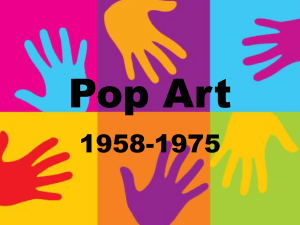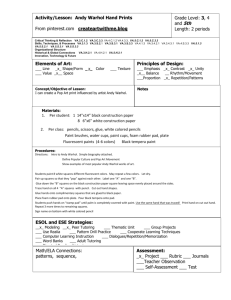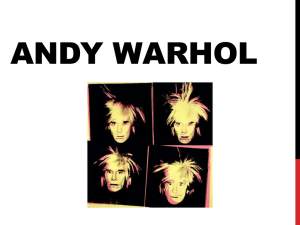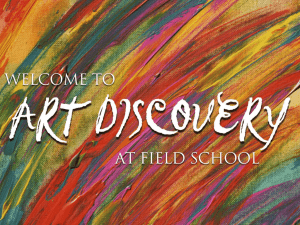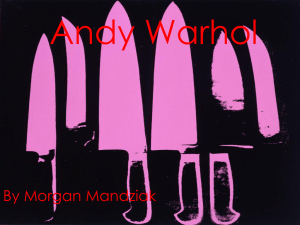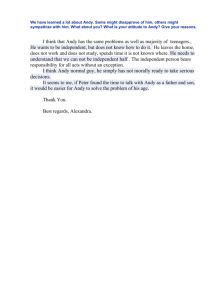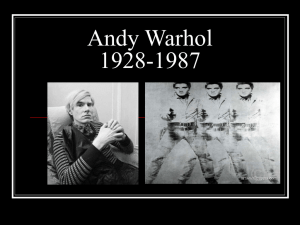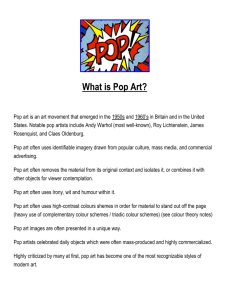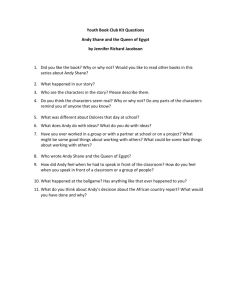The Pop Art Movement
advertisement
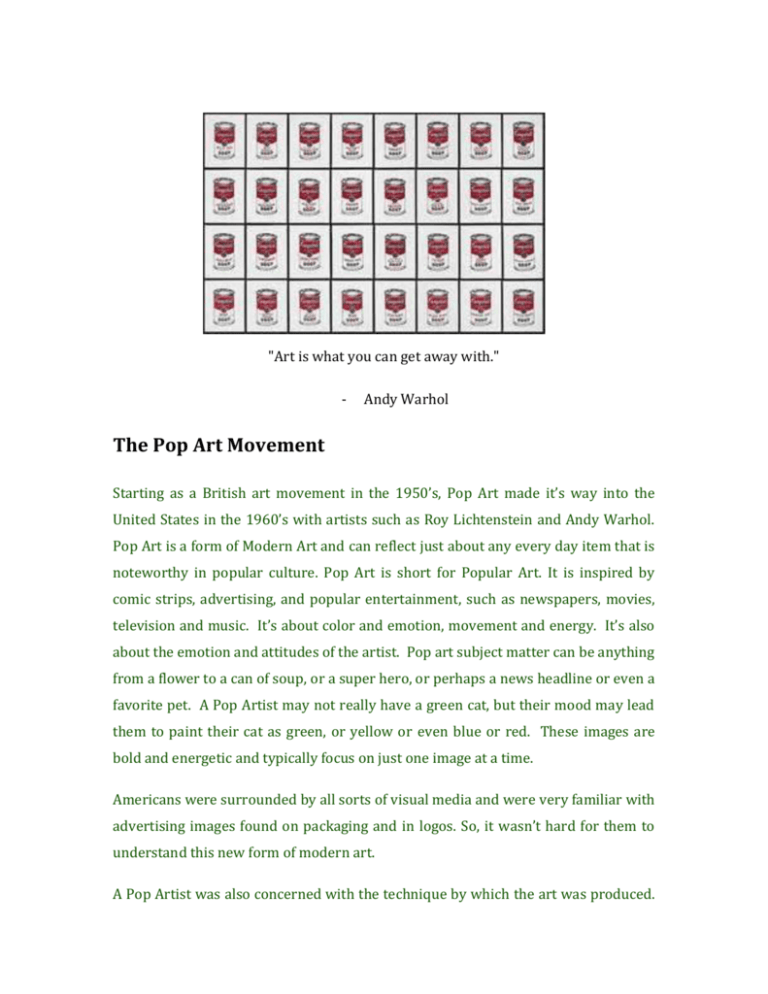
"Art is what you can get away with." - Andy Warhol The Pop Art Movement Starting as a British art movement in the 1950’s, Pop Art made it’s way into the United States in the 1960’s with artists such as Roy Lichtenstein and Andy Warhol. Pop Art is a form of Modern Art and can reflect just about any every day item that is noteworthy in popular culture. Pop Art is short for Popular Art. It is inspired by comic strips, advertising, and popular entertainment, such as newspapers, movies, television and music. It’s about color and emotion, movement and energy. It’s also about the emotion and attitudes of the artist. Pop art subject matter can be anything from a flower to a can of soup, or a super hero, or perhaps a news headline or even a favorite pet. A Pop Artist may not really have a green cat, but their mood may lead them to paint their cat as green, or yellow or even blue or red. These images are bold and energetic and typically focus on just one image at a time. Americans were surrounded by all sorts of visual media and were very familiar with advertising images found on packaging and in logos. So, it wasn’t hard for them to understand this new form of modern art. A Pop Artist was also concerned with the technique by which the art was produced. Many times, this sort of art showed images of things that were mass-produced such as soup cans, money and bottles. As a result, these artists felt it necessary to massproduce their actual art pieces. In the case of Andy Warhol, he chose a form of printing called screen-printing, more specifically silkscreen, to mass-produce his art. Screen-printing, also known as serigraphy, is a method of creating multiple images on paper, fabric or some other object by pressing ink through a screen with areas blocked off by a stencil. The original piece of art would serve as the stencil. As a result, the artist would then have the ability to make many copies of his original piece of art. Andy Warhol, “The Prince of Pop” (1928-1987) Andy Warhol , originally known as Andy Warhola, was born in Pittsburgh, Pennsylvania in 1928. His parents were recent immigrants to the United States from what is now Slovakia. As a child, Warhol, was often sick, so he spent a lot of time in bed and his mom served him a lot of Campbell’s Soup. Just like any child, he needed something to do and since he couldn’t go outside and play, he would draw, listen to the radio and collect pictures of movie stars. Looking back later, Warhol described this period of his childhood as very important in the development of his personality and eventually, the art he produced. Early on, Warhol showed an artistic talent and studied commercial art at Carnegie Mellon University in Pittsburgh. When he was 21, he moved to New York City and began a successful career in magazine illustration and advertising. He became very popular, especially for his drawings of shoes. He kept very busy illustrating record covers, books, magazine covers and greeting cards. He even drew the raindrops and clouds for the weather reports that ran on TV. During the 1960’s, Warhol transformed himself from an advertising illustrator into one of the most famous American artists of the day. During the 1960s, Warhol began creating the paintings he is best known for today. Warhol loved “pop culture” (popular culture) so he decided to paint what he loved. He painted dollar bills, celebrities, and brand name products, like Campbell’s Soup Cans and Coca-Cola. Many of these subjects are things that are mass-produced, or produced in a factory or plant, so he thought it appropriate that he should mass produce the art itself. He declared himself “a machine” and it was then that he decided to silkscreen his prints so more and more people could own his pieces. Warhol was at times criticized for turning art into a business. Many people didn’t like the idea that he was just making copies of the same picture to sell and make money. What made these prints unique was that Warhol added little details to each one after printing to make them truly originals. Andy Warhol gained a lot of popularity with other artists, writers, celebrities and musicians. It was during this time that Warhol founded a studio called "The Factory." This was a place where these people could gather to share their ideas, inspire each other’s work and see just how Andy was producing his own art. He even included some of these famous people in films and paintings that he made. Andy also loved his cats and illustrated them often. It was noted that a famous celebrity gave Andy his first cat named Hester. And then along came Sam, Andy’s second cat. Sam was the name he then gave to the rest of the cats that would live in his five-story apartment building in New York City. If you can believe it, 25 cats were all named Sam! Campbell’s Soup Cans When Warhol first exhibited Campbell’s Soup Cans, in 1962, each of the thirty-two canvases rested on a shelf mounted on the wall, like groceries in a store. The number of paintings corresponds to the varieties of soup then sold by the Campbell Soup Company. Warhol assigned a different soup variety to each, checking them off on a product list supplied by Campbell once their “portraits” were completed. Andy Warhol did not originally seek permission from Campbell Soup Company to paint their soup cans. He apparently did not run into problems with the company who saw his usage as amusing and the freedom of expression. Cats Named Sam It is true that Andy Warhol lived with one blue (gray) cat named Hester and another named Sam. As the kittens came along (12 in one litter and 13 in another), he named them all Sam since they looked most like their father. Andy loved to illustrate and paint these cats but the five story apartment building was beginning to be overrun by his furry friends. As an attempt to have the cats adopted he put together a book of his illustrations called 25 Cats Name Sam and One Blue Pussy Cat. It was after this book was published that it is said that people came in droves to adopt Andy’s cats. Questions 1. When you think of the word “pop” what images come to your mind? Are they bold? Bright? Exciting? 2. How many cans of soup are in the PowerPoint slide? (answer 100) 3. What does it mean when someone says, “a picture is worth a thousand words?” Do you think this could apply to Andy Warhol’s art pieces you have seen today? 4. It is said that Andy Warhol’s mom served him Campbell’s Soup nearly every day for 20 years! Do you have a favorite soup flavor? Or, can you think of a food that you love to eat a lot of now that you may illustrate or paint one day? 5. Andy Warhol loved to paint his cats and 25 of them were named Sam. What do you think it would be like to have 25 cats with the same name? 6. The cats were all painted different colors. How does each color make you feel? What is the mood created by each color? 7. Based on a book by Andy Warhol’s nephew, Andy Warhol’s brother was a junk dealer in Pennsylvania. He would bring his family to visit Andy in NYC and often bring interesting pieces of trash/junk as a “housewarming gift.” Have you ever turned a piece of trash into an artistic treasure? 8. What sorts of every day objects do you think that Andy Warhol would paint today to reflect this time in history? 9. How do you think the Campbell’s Soup Company felt about a famous artist illustrating their products? Do you think companies like Nike or Target would feel the same way today? 10. Andy Warhol lived in a five-story apartment building that was crowded with all sorts of inspirational pieces. If you were to look around the classroom or your own room, what sorts of things would inspire you? Activities 1. This is a GREAT YouTube clip! It has pop music (Justin Beiber) and the students can read a long and learn about Andy Warhol as they see some fantastic images. Lasts about 3 minutes. Even if they can’t all read well, the images and music are still worth it. http://www.youtube.com/watch?v=ulZ64VDhwXM 2. Here is a link to a Campbell’s soup can that can be printed for the students to color or take home. I will also try to put a copy of this on as an attachment to the lesson. http://museumchick.com/2010/04/museumkid-free-coloring-book-pages.html. 3. Two books are on reserve. Uncle Andy’s Cats, which is a quick read along with great pictures of Andy Warhol’s home and all of his cats. It is a silly book and could be read or the pictures could be shown. The other book, Uncle Andy’s, is a little longer but tells the story of James Warhola, Andy’s nephew and the trips he took to visit his eccentric uncle in NYC. It can take about 15 minutes to read but also has some great pictures to show the children of how Andy lived and how his home was crowded with inspirational pieces. 4. Andy drew a lot of shoes for advertisements and for fun. His drawings appeared in the newspaper every week. Draw your own fantasy shoe for an advertisement. What will your shoe look like? It could be an animal, a machine a building or even a person. 5. Andy Warhol had his own time capsule of more than 600 boxes with things from his daily life. Make a list of things you would include in your time capsule of our own popular culture. This activity can be done as a table exercise or individually. If done as a table, have each table take a minute to read their lists to the class. If done individually, I have included link to a “cube” that can be decorated. (There are other shapes on this site too). The time capsule items can be listed on the inside then the cube can be cut out and taped together. They can also write things like “Sealed on this day…” “Don’t open until this day…” You will need to bring paper and tape for this activitiy. http://www.senteacher.org/wk/3dshape.php 6. Use the first slide of the PowerPoint presentation with the word “POP” on it. Give the children a minute to brainstorm every word that comes to mind when they hear this word. They can write them on the board. Talk about the meaning of each word and image. Do these words show bright, colorful images? Perhaps loud or fun? 7. The last slides on the PowerPoint file have images of labels and packaging that exist in our current popular culture. You can click through them and name them with the class. You can also have them draw in repetition one of these images just like Andy Warhol had done with the soup cans. 8. With some notice, you can ask the students to bring a picture to school that can be traced. It can be of a pet, themselves, etc… You will need to provide tracing paper for this exercise so they can trace their own images over and over and then color them in different colors. Most classes have markers and crayons but please check with the teachers first. References http://library.thinkquest.org www.artz.org www.wikipedia.com www.moma.com www.mykidsart.com www.ask.com
